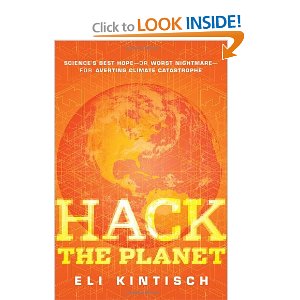
![]() Tour of the Horizon, the Smartest of Skeptics
Tour of the Horizon, the Smartest of Skeptics
July 25, 2010
Eli Kintisch
I bristled when I saw the title, but bought the book in association with my own talk to Hackers on Planet Earth (HOPE) on “Hacking Humanity.” I've put the book down glad I did not give up in the early pages, and thoroughly impressed by the author, clearly among the smartest of skeptics.
Although I was suprised to find no mention of HAARP (High Frequency Active Auroral Research Program) which is striving for openness but still appears to have an unnerving patina of weather change and earthquake triggering potential–in my uninformed view. I'd love the author's informed opinion on HAARP.
What the author does provide in this book is a totally superb overview with multiple drill-downs of what is now called “geoengineering.” Geo-systems are not in this book, and that is the greatest flaw with any contemplation of geo-engineering–you cannot engineer what you cannot understand.
The arrogance of those proposing “methods” to “hack” the Earth is truly outstanding, an arrogance I am glad to see that the author does not share. Among the long list of ideas:
Aerosols into the upper atmosphere
Aluminum mesh into the upper atmosphere
Ash in the upper atmosphere
Bury Co2 deep in the ground or under the seabed
Carbons into carbides into cement
Chemicals in the upper atmosphere
Cloud seeding
Divert rivers
Dust rings in the upper atmosphere
Grow lots of algae in the ocean
Harnessing volcanoes
Plants everywhere
Suck Co2 out of the air
Trillions of reflective disks floating in the upper atmosphere
All of the above are a right of center counter-attack to the left of center climate change carbon fraud that received a major setback when years of emails were released just prior to the Copenhagen conference. For a good time search for ClimateGate.
With any of the above, there is at least a 1 in 300 change of altering the climate toward extremes.
The four scenarios that scare people–and that the right of center scientists do not think will be addressed by carbon reducing strategies– include:
Catastrophic methane release
Collapsing ice sheets
Megadroughts
Slowing of ocean conveyor belt
An enormous amount of ignorance is ably documented by the author, who certainly gives all those concerned their due in terms of brilliance, dedication, good intentions, and creative ideas. The models are “not even close” at the same time that the linkages are not understood. “Flawed data” and “bad analysis” are the norm. No real sense of levers and amplifiers among all those contemplating “hacks” on the earth.
I learn the word “homodisciplinary” and I love it–that alone is worth the price of the book because that one books slams down at least 80% of not 90% of all of the so-called “experts” that know everything about nothing and nothing about everything else.
I am stunned to see that the carbon fraud scheme by Maurice Strong and his trusty talking puppet Al Gore is said to be a one trillion dollar market–this certainly makes sub-prime mortgages look good in comparison.
The most promising offerings appear to be carbon into carbides into cement; algae in oceans, and cloud seeking. HOWEVER, as this book makes clear in both the text and the fine print, geoengineering is climate change fraud on steroids, a 9 billion pound gorilla with no idea of its potential for catastrophe.
I am pointed toward a number of excellent books by this author, including Stewart Brand's Whole Earth Discipline: Why Dense Cities, Nuclear Power, Transgenic Crops, Restored Wildlands, and Geoengineering Are Necessary; James Loveluck's The Vanishing Face of Gaia: A Final Warning; and Bjorn Lomborg's Global Crises, Global Solutions: Costs and Benefits.
The author does a fine job of showing how tinkering leads to disaster, with case studies on the Aral Sea, Lake Victorial, the gall fly helping deer mice multiply as disease carriers, and dung beetles doing good.
A fine quote: “We just do not know the side effects” [of anything we might do].
In discussing the algae in the Arctic the author provides an excellent sense of the complex over-lapping and often contradictory and certainly debilitating jurisdictions and obstacles associated with multiple governments and within governments, between multiple agencies as well as many alert civil society elements.
The author wins his fifth star at the very end, when I realize that his balanced objectivety throughout has been concealing an erudite sarcasm about “Hack the Planet.” He ends with a short brilliant discourse on “the problem of the dual and deceptive nature of control,” and a quote with respect to how we are playing God and actually have no clue.
Although there is nothing in this book about ecological economics, true cost, scarcity and toxins and so on, this is a book by a journalist and I found it most satisfying; future books by this author will capture my attention.
Here are seven other books (Amazon limits us to ten, you can find the other 1600+ at Phi Beta Iota the Public Intelligence Blog, see especially 00 Remixed Review Lists (69) halfway down the middle column).
In the Absence of the Sacred: The Failure of Technology and the Survival of the Indian Nations
Silicon Snake Oil: Second Thoughts on the Information Highway
Climategate: A Veteran Meteorologist Exposes the Global Warming Scam
The Outlaw Sea: A World of Freedom, Chaos, and Crime
Water: The Fate of Our Most Precious Resource
The Future of Life
High Noon 20 Global Problems, 20 Years to Solve Them




